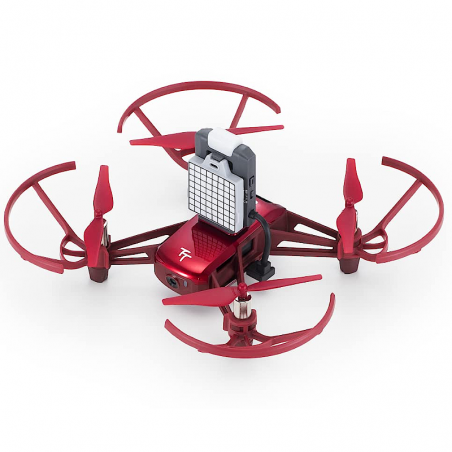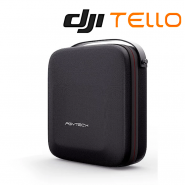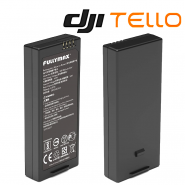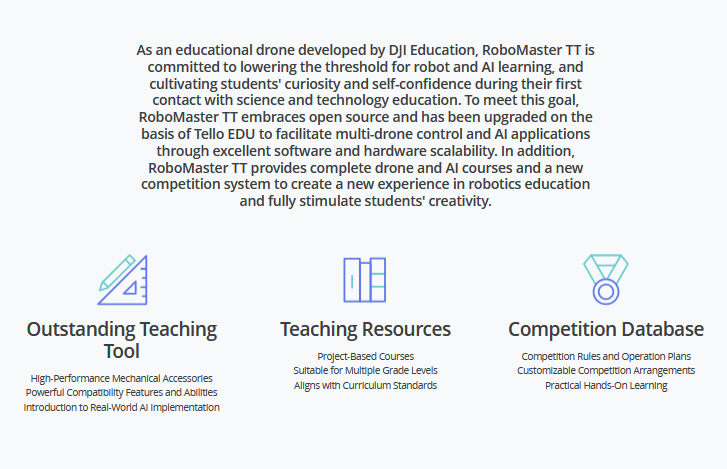

DJI Tello Mini Drone Mala Proteção e...
- Em promoção!
- -10,00 €







O RoboMaster TT Tello Talent é um drone educacional desenvolvido pela DJI, projetado para ensinar programação e inteligência artificial de maneira prática e interativa. Com uma plataforma em Open Source, este drone permite a quem o programa executar uma variedade de funcionalidades, como reconhecimento facial, controlo por gestos e mapeamento de superfícies. Além de oferecer um voo estável, o TT Tello Talent também é capaz de trabalhar com sensores externos, tornando-o ideal para projetos em IA. Por fim, este drone conta com conectividade Wi-Fi e incluí uma matriz de LED 8x8, que podes programar para apresentar vários padrões, animações ou caracteres.
Se quiseres saber mais informações sobre este produto, consulta a página do fabricante.
DESCRIÇÃO EM PORTUGUÊS BREVEMENTE DISPONÍVEL
Se tiver alguma dúvida neste produto não hesite em contactar-nos.
*Atenção: as imagens são meramente ilustrativas.


A Small Drone for Big Dreams
As the industry's leading educational drone, RoboMaster TT delivers powerful flight performance with a compact footprint, and uses the cutting-edge DJI flight control algorithms to ensure flight safety and stability. It also has a 5MP HD camera, which delivers smooth and stable flight images. The newly added ESP32 open-source module and other programmable modules are combined with a diverse programming environment to create a professional drone education platform that is convenient for both teachers and students.
Open source, customizable gameplay
Built-in ESP32 open source module: The built-in ESP32 chip provides the Arduino and Micro Python open source programming environments, and supports the Arduino, Micro Python, graphical programming, and multiple offline programming methods. It creates an open-source flying hardware platform for students and teachers that makes it convenient for students to learn embedded programming and develop various applications of aerial robots.

Light flickering with the drone for a better visual experience
Programmable breathing indicator: When using RoboMaster TT with the RGB full-color LED indicator, you can control the light color and flashing frequency through graphical programming, Python, Arduino, and other programming methods. In this way, the programming result is more intuitive, and the flight effect is more impressive.

More innovations displayed on the screen
Programmable dot-matrix screen: RoboMaster TT has an 8×8 red-and-blue LED dot-matrix screen. You can use the graphical programming, Python, Arduino and other programming methods to display various simple patterns, simple animations, or scrolling characters on the dot-matrix screen. On this basis, the dot-matrix screen provides more possibilities for man-drone interaction.

Distance measurement, obstacle avoidance, and intelligent awareness
Integrated ToF infrared ranging sensor: RoboMaster TT is integrated with a single-point ToF sensor, with the maximum measurement distance of 1.2 meters. The drone is suitable for a range of applications in various teaching scenarios, and can implement environmental perception and intelligent obstacle avoidance.

Highly stable dual-band communication
New 5.8-GHz Wi-Fi module: This module supports 2.4-GHz/5.8-GHz dual-band communication, which greatly improves the stability of the drone connection and enables the drone to better adapt to its environment. The drone can fly smoothly in complex Wi-Fi environments. In the classroom teaching scenario, more drones can be connected simultaneously than before, and the stability of multi-drone formation is enhanced.

Explore more possibilities
Adapter extension board: It provides the 2×7-pin 2.54-mm in-line package interface, supports the I2C, SPI, UART, and GPIO programming protocols, and provides the 5-V/3.3-V power supply. With this board, you can easily add and debug new sensors for more creative ideas.

RoboMaster TT's highly integrated open source extension kit can be used together with its open camera video stream data to implement more diversified AI applications. In addition, by using the new RoboMaster SDK, cutting-edge AI technologies such as machine vision and deep learning can be used in the classrooms of primary and secondary schools. This makes AI more familiar, and enables learning through play for better results with more fun.
RoboMaster TT comes with a sensor adapter, which supplies power for third-party sensors. The official DJI SDK is also available to all users in order to support multiple programmable sensor interfaces, such as I2C, SPI, UART, and GPIO. Students can easily expand sensors and develop programs to produce more AI applications.

With the Python 3.0 RoboMaster SDK, you can easily learn the Python language and program to control drones. You can also use the SDK to create your own applications, implement the interaction between RoboMaster TT and RoboMaster EP, develop your own AI algorithms, and give full play to your creativity.

By adding different third-party sensors to RoboMaster TT, you can customize a variety of creative gameplay.
Use the infrared ranging technology and obstacle information data to perceive the environment and draw indoor maps. You can learn about the indoor robot navigation technology and automatic obstacle avoidance.

Obtain the video stream for facial recognition and tracking. You can learn cutting-edge AI technologies, such as machine vision, deep learning, and convolutional neural network.

Use gesture recognition sensors and program the drone to obtain gesture information and control actions of the drone. You can learn how the sensor data is read (where separate sensors are required), and implement man-drone interaction.

Based on the obtained knuckle movement posture information, develop a program to establish a connection between palm postures and flight actions, and implement palm control (where separate sensors are required). You can understand and learn about microelectronics technology and sensor characteristics.

Easily Set up Multi-Drone Formation
RoboMaster TT supports the Station mode. Therefore, multiple RoboMaster TT devices can be connected to the same Wi-Fi router, receive programming code instructions, and provide feedback, implementing status synchronization and control of multiple drones. You can use the drone for various purposes during teaching, competition, or performance.
Safer
RoboMaster TT adopts a safety-first design and incorporates the following physical and software protection methods to ensure user flight safety: blade protection, precise hovering, and low-battery alarming.

Stabler
RoboMaster TT uses the new 5.8-GHz Wi-Fi module, which features a lower signal transmission delay and better anti-signal-interference performance. On this basis, the multi-drone formation process and experience become smoother.

Simpler
RoboMaster TT supports using graphical programming, Python, and other programming languages for multi-drone formation programming. In addition, students can use the app to easily and quickly set up simple multi-drone formation.

More impressive
With the programmable LED indicators, music, and actions, RoboMaster TT can change lighting colors and their frequencies, delivering an even more impressive multi-drone formation effect.

More Fun
With the programmable dot-matrix screen, RoboMaster TT can change patterns on the dot-matrix screen during multi-drone formation to convey unique ideas.

AI Competition
Develop a program to control the drone to automatically cross obstacles and select the correct landing position to implement accurate landing based on the image recognition results. Knowledge points: image recognition and PID control.

Air-Ground Operation
The drone conducts reconnaissance in the air and sends the location information to the unmanned vehicle. The unmanned vehicle automatically arrives at the destination and transports materials. Knowledge points: image recognition, air-to-ground communication, and route planning.

Maze Race
Develop a program to enable the drone to autonomously explore a way out in a maze with random routes. The maze also contains mission pads with hidden tasks.Knowledge points: indoor positioning, ToF sensor usage, intra-maze searching, and programmable dot-matrix screen.

Produtos Associados

